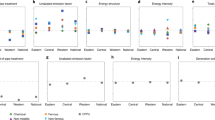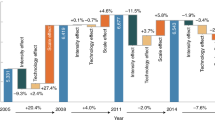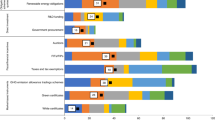Abstract
Urgently needed carbon emissions reductions might lead to strict command-and-control decarbonization strategies with potentially negative economic consequences. Analysing the entire firm-level production network of a European economy, we have explored how the worst outcomes of such approaches can be avoided. We compared the systemic relevance of every firm in Hungary with its annual CO2 emissions to identify optimal emission-reducing strategies with a minimum of additional unemployment and economic losses. Setting specific reduction targets, we studied various decarbonization scenarios and quantified their economic consequences. We determined that for an emissions reduction of 20%, the most effective strategy leads to losses of about 2% of jobs and 2% of economic output. In contrast, a naive scenario targeting the largest emitters first results in 28% job losses and 33% output reduction for the same target. This demonstrates that it is possible to use firm-level production networks to design highly effective decarbonization strategies that practically preserve employment and economic output.
This is a preview of subscription content, access via your institution
Access options
Access Nature and 54 other Nature Portfolio journals
Get Nature+, our best-value online-access subscription
$29.99 / 30 days
cancel any time
Subscribe to this journal
Receive 12 digital issues and online access to articles
$119.00 per year
only $9.92 per issue
Buy this article
- Purchase on Springer Link
- Instant access to full article PDF
Prices may be subject to local taxes which are calculated during checkout



Similar content being viewed by others
Data availability
The data on the financial transactions between Hungarian VAT-paying firms that support the findings of this study are available at the National Bank of Hungary, but restrictions apply to the availability of these data, which were used under licence in the current study by directly accessing the servers of the National Bank of Hungary and so are not publicly available. Requests for collaborations can be addressed to olahzs@mnb.hu
Code availability
The Python library pyeutl39, which was used to obtain the CO2 emissions of Hungarian firms, is open source and available at https://github.com/jabrell/pyeutl. The core components of the analysis, that is, the extraction of CO2 emissions data for Hungarian ETS firms, the code to calculate the ESRI and the initialization of the studied decarbonization strategies are available at https://github.com/jo-stangl/reducing_employment_and_economic_output_loss_in_rapid_decarbonization_scenarios.
References
Masson-Delmotte, V. et al. (eds) Global Warming of 1.5 °C. An IPCC Special Report on the Impacts of Global Warming of 1.5 °C Above Pre-industrial Levels and Related Global Greenhouse Gas Emission Pathways, in the Context of Strengthening the Global Response to the Threat of Climate Change, Sustainable Development, and Efforts to Eradicate Poverty (IPCC, 2018).
Nordhaus, W. D. Revisiting the social cost of carbon. Proc. Natl Acad. Sci. USA 114, 1518–1523 (2017).
Tol, R. S. On the optimal control of carbon dioxide emissions: an application of FUND. Environ. Model. Assess. 2, 151–163 (1997).
Hope, C. Critical issues for the calculation of the social cost of CO2: why the estimates from PAGE09 are higher than those from PAGE2002. Climatic Change 117, 531–543 (2013).
Stehfest, E. et al. Integrated Assessment of Global Environmental Change with IMAGE 3.0—Model Description and Policy Applications (Netherlands Environmental Assessment Agency, 2014); http://www.pbl.nl/en/publications/integrated-assessment-of-global-environmental-change-with-IMAGE-3.0
Huppmann, D. et al. The MESSAGEix Integrated assessment model and the ix modeling platform (ixmp). Environ. Model. Softw. 112, 143–156 (2019).
Fujimori, S., Masui, T. & Matsuoka, Y. Development of a global computable general equilibrium model coupled with detailed energy end-use technology. Appl. Energy 128, 296–306 (2014).
Calvin, K. et al. GCAM v5.1: representing the linkages between energy, water, land, climate, and economic systems. Geosci. Model Dev. 12, 677–698 (2019).
Popp, A. et al. The economic potential of bioenergy for climate change mitigation with special attention given to implications for the land system. Environ. Res. Lett. 6, 034017 (2011).
Bosetti, V., Carraro, C., Duval, R. & Tavoni, M. What should we expect from innovation? A model-based assessment of the environmental and mitigation cost implications of climate-related R&D. Energy Econ. 33, 1313–1320 (2011).
Mercure, J.-F. et al. Environmental impact assessment for climate change policy with the simulation-based integrated assessment model E3ME-FTT-GENIE. Energy Strategy Rev. 20, 195–208 (2018).
Lamperti, F., Dosi, G., Napoletano, M., Roventini, A. & Sapio, A. Faraway, so close: coupled climate and economic dynamics in an agent-based integrated assessment model. Ecol. Econ. 150, 315–339 (2018).
Ciarli, T. & Savona, M. Modelling the evolution of economic structure and climate change: a review. Ecol. Econ. 158, 51–64 (2019).
Haas, A. & Jaeger, C. Agents, Bayes, and Climatic Risks—a modular modelling approach. Adv. Geosci. 4, 3–7 (2005).
Mandel, A., Fürst, S., Lass, W., Meissner, F. & Jaeger, C. Lagom generiC: An Agent-Based Model of Growing Economies Working Paper No. 1 (European Climate Forum, 2009).
Wolf, S. et al. A multi-agent model of several economic regions. Environ. Model. Softw. 44, 25–43 (2013).
Lamperti, F. et al. Towards agent-based integrated assessment models: examples, challenges, and future developments. Reg. Environ. Change 19, 747–762 (2019).
Diem, C., Borsos, A., Reisch, T., Kertész, J. & Thurner, S. Estimating the loss of economic predictability from aggregating firm-level production networks. PNAS Nexus 3, pgae064 (2024).
Hallegatte, S. An adaptive regional input–output model and its application to the assessment of the economic cost of Katrina. Risk Anal. 28, 779–799 (2008).
Inoue, H. & Todo, Y. Firm-level propagation of shocks through supply-chain networks. Nat. Sustain. 2, 841–847 (2019).
Carvalho, V. M., Nirei, M., Saito, Y. U. & Tahbaz-Salehi, A. Supply chain disruptions: evidence from the Great East Japan Earthquake. Q. J. Econ. 136, 1255–1321 (2021).
Bierkandt, R., Wenz, L., Willner, S. N. & Levermann, A. Acclimate—a model for economic damage propagation. Part 1: basic formulation of damage transfer within a global supply network and damage conserving dynamics. Environ. Syst. Decis. 34, 507–524 (2014).
Wenz, L., Willner, S. N., Bierkandt, R. & Levermann, A. Acclimate—a model for economic damage propagation. Part II: a dynamic formulation of the backward effects of disaster-induced production failures in the global supply network. Environ. Syst. Decis. 34, 525–539 (2014).
Leontief, W. Environmental repercussions and the economic structure: an input–output approach. Rev. Econ. Stat. 52, 262–271 (1970).
Wiedmann, T., Lenzen, M., Turner, K. & Barrett, J. Examining the global environmental impact of regional consumption activities—part 2: review of input–output models for the assessment of environmental impacts embodied in trade. Ecol. Econ. 61, 15–26 (2007).
Tukker, A. et al. Exiopol—development and illustrative analyses of a detailed global MT EE SUT/IOT. Econ. Syst. Res. 25, 50–70 (2013).
King, M., Tarbush, B. & Teytelboym, A. Targeted carbon tax reforms. Eur. Econ. Rev. 119, 526–547 (2019).
Diem, C., Borsos, A., Reisch, T., Kertész, J. & Thurner, S. Quantifying firm-level economic systemic risk from nation-wide supply networks. Sci. Rep. 12, 7719 (2022).
Borsos, A. & Stancsics, M. Unfolding the Hidden Structure of the Hungarian Multi-layer Firm Network MNB Occasional Papers 2020/139 (Magyar Nemzeti Bank, 2020).
Xu, M. & Liang, S. Input–output networks offer new insights of economic structure. Physica A 527, 121178 (2019).
Curtis, E. M., O’Kane, L. & Park, J. in Environmental and Energy Policy and the Economy Vol. 5, Ch. 4 (NBER, 2023).
World Energy Outlook 2022 (International Energy Agency, 2022); https://www.iea.org/reports/world-energy-outlook-2022
Poledna, S. & Thurner, S. Elimination of systemic risk in financial networks by means of a systemic risk transaction tax. Quant. Finance 16, 1599–1613 (2016).
Diem, C., Pichler, A. & Thurner, S. What is the minimal systemic risk in financial exposure networks? J. Econ. Dyn. Control 116, 103900 (2020).
Pichler, A., Poledna, S. & Thurner, S. Systemic risk-efficient asset allocations: minimization of systemic risk as a network optimization problem. J. Fin. Stab. 52, 100809 (2021).
20.2.1.47. Number of employees by economic branches, monthly, monthly cumulative and quarterly cumulative data. Hungarian Central Statistical Office https://www.ksh.hu/stadat_files/mun/en/mun0197.html (accessed 8 June 2023).
EU ETS Handbook (European Commission, 2015); https://climate.ec.europa.eu/system/files/2017-03/ets_handbook_en.pdf
European Union transaction log European Commission https://climate.ec.europa.eu/eu-action/eu-emissions-trading-system-eu-ets/union-registry_en (2022).
Abrell, J. EUETS.INFO. EUETS.INFO https://euets.info/ (2022).
Hungary 2022 Energy Policy Review (International Energy Agency, 2022); https://iea.blob.core.windows.net/assets/9f137e48-13e4-4aab-b13a-dcc90adf7e38/Hungary2022.pdf
Mealy, P., Del Rio-Chanona, R. M. & Farmer, J. D. What you do at work matters: new lenses on labour. Preprint at https://www.ssrn.com/abstract=3143064 (2018).
Del Rio-Chanona, R. M., Mealy, P., Beguerisse-Díaz, M., Lafond, F. & Farmer, J. D. Occupational mobility and automation: a data-driven network model. J. R. Soc. Interface 18, 20200898 (2021).
Acknowledgements
This work was supported in part by the Austrian Federal Ministry for Climate Action, Environment, Energy, Mobility, Innovation and Technology as part of the funding project GZ 2021-0.664.668 (S.T.), the Austrian Science Fund FWF under P 33751 (S.T.), the Austrian Science Promotion Agency FFG project under 39071248 (S.T.) and the OeNB Hochschuljubiläumsfund P18696 (S.T.). We thank J. Kertesz for helpful discussions.
Author information
Authors and Affiliations
Contributions
J.S. and S.T. conceived the work. A.B. cleaned and prepared the data. J.S. and A.B. wrote the code. J.S., A.B., C.D., T.R. and S.T. performed the data analysis. All authors analysed and interpreted the results. J.S. and S.T. wrote the paper. All of the authors contributed to the final paper.
Corresponding author
Ethics declarations
Competing interests
The authors declare no competing interests.
Peer review
Peer review information
Nature Sustainability thanks Francesco Lamperti, Luca Mungo and the other, anonymous, reviewer(s) for their contribution to the peer review of this work.
Additional information
Publisher’s note Springer Nature remains neutral with regard to jurisdictional claims in published maps and institutional affiliations.
Supplementary information
Supplementary Information
Supplementary Discussion, Figs. 1–11 and Tables 1–3.
Rights and permissions
Springer Nature or its licensor (e.g. a society or other partner) holds exclusive rights to this article under a publishing agreement with the author(s) or other rightsholder(s); author self-archiving of the accepted manuscript version of this article is solely governed by the terms of such publishing agreement and applicable law.
About this article
Cite this article
Stangl, J., Borsos, A., Diem, C. et al. Firm-level supply chains to minimize unemployment and economic losses in rapid decarbonization scenarios. Nat Sustain (2024). https://doi.org/10.1038/s41893-024-01321-x
Received:
Accepted:
Published:
DOI: https://doi.org/10.1038/s41893-024-01321-x



